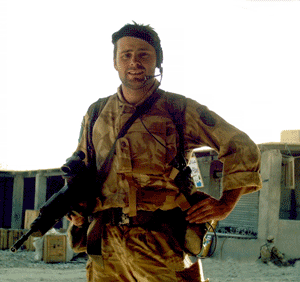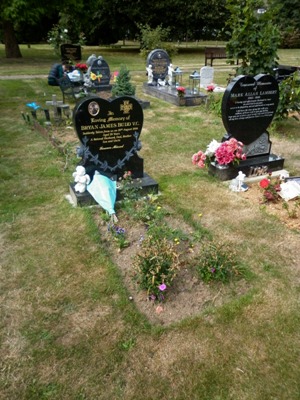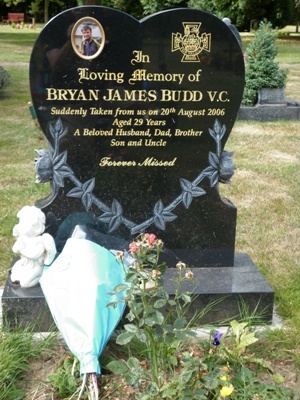His Victoria Cross citation reads, "The Queen has been graciously pleased to approve the posthumous award of the Victoria Cross to the undermentioned:
25048092 Corporal Bryan James Budd, The Parachute Regiment (killed in action) During July and August 2006 A Company, 3rd Battalion The Parachute Regiment were deployed to occupy once again the District Centre at Sangin. The company's location was constantly under sustained attack from a combination of Taliban small arms, rocket-propelled grenades, mortar and rocket fire. In order to reduce this threat platoons were regularly tasked to conduct security patrols into the urban and rural areas in the vicinity of the District Centre. Given the prevailing enemy activity in the area it was assessed that patrols had a 75 per cent chance of coming into contact with the Taliban—a statistic that was not lost on the men of A Company. These patrols regularly came under attack and on 27th July Corporal Budd's section identified and engaged two enemy gunmen on the roof of a building in the centre of Sangin. This provoked a fierce fire-fight in which two of Corporal Budd's section were hit. One was seriously injured and collapsed in the open ground, where he remained exposed to enemy fire, with rounds striking the ground around him. Realising that he needed to regain the initiative and understanding that the enemy needed to be driven back so that the casualty could be evacuated, Corporal Budd led his section forward and assaulted the building where the enemy fire was heaviest. He led this attack under fire and personally killed two of the enemy inside the building with grenade and rifle fire, forcing the remaining fighters to flee across an open field where they were successfully engaged by the rest of his section. This courageous and prompt action proved decisive in breaking the enemy and was undertaken at great personal risk. In inflicting significant losses amongst the enemy and forcing their withdrawal, Corporal Budd's deliberate action and conspicuous gallantry also allowed the wounded soldier to be evacuated to safety where he subsequently received life-saving treatment. On 20th August Corporal Budd was leading his section on the right forward flank of a platoon clearance patrol near Sangin District Centre. Another section was advancing with a Land Rover fitted with a .50calibre heavy machine gun on the patrol's left flank. Pushing through thick vegetation, Corporal Budd identified a number of enemy fighters 30metres away to his front. As he had not been seen by these Taliban, Corporal Budd indicated their presence to the rest of his section and used hand signals to prepare his men to launch a hasty attack .He then led his section on a flanking manoeuvre but the enemy engaged the Land Rover on the left flank and the element of surprise Corporal Budd had hoped to achieve was lost as his own section was also spotted. Recognising the immediate requirement to regain the initiative, Corporal Budd made a conscious decision to assault the enemy and ordered his men to follow him. As they moved forward the section came under a withering fire that quickly wounded two men and incapacitated a further soldier when a bullet struck his body armour. The effectiveness of the enemy's fire and these losses forced the unwounded members of the section to take cover. However, Corporal Budd continued to assault forward on his own, knowing full well the likely consequences of doing so without the close support of his remaining men. He was wounded but he continued to move forward, firing at the enemy and accounting for a number of them as he rushed their position. Inspired by Corporal Budd's example, the rest of the platoon reorganised and pushed forward their attack, killing more of the enemy and eventually forcing their withdrawal. Corporal Budd subsequently died of his wounds and when his body was later recovered it was found surrounded by three dead Taliban. There is no doubt that Corporal Budd first demonstrated conspicuous gallantry in leading the assault on 27th July 2006, an assault which broke the enemy and ultimately saved the life of a wounded member of his section. What is remarkable is that he did this again on 20th August in the knowledge that the rest of his men had either been struck down by enemy fire or had been forced to go to ground. Throughout his service in Afghanistan Corporal Budd led his section from the front and was always at the point where the action was fiercest. Twice he behaved with the greatest gallantry but his single-handed action on the second occasion and his determination, though wounded, to push on against a superior enemy force stands out as a premeditated act of inspirational leadership and the greatest valour, which cost him his life."
His Victoria Cross citation reads, "The Queen has been graciously pleased to approve the posthumous award of the Victoria Cross to the undermentioned:
25048092 Corporal Bryan James Budd, The Parachute Regiment (killed in action) During July and August 2006 A Company, 3rd Battalion The Parachute Regiment were deployed to occupy once again the District Centre at Sangin. The company's location was constantly under sustained attack from a combination of Taliban small arms, rocket-propelled grenades, mortar and rocket fire. In order to reduce this threat platoons were regularly tasked to conduct security patrols into the urban and rural areas in the vicinity of the District Centre. Given the prevailing enemy activity in the area it was assessed that patrols had a 75 per cent chance of coming into contact with the Taliban—a statistic that was not lost on the men of A Company. These patrols regularly came under attack and on 27th July Corporal Budd's section identified and engaged two enemy gunmen on the roof of a building in the centre of Sangin. This provoked a fierce fire-fight in which two of Corporal Budd's section were hit. One was seriously injured and collapsed in the open ground, where he remained exposed to enemy fire, with rounds striking the ground around him. Realising that he needed to regain the initiative and understanding that the enemy needed to be driven back so that the casualty could be evacuated, Corporal Budd led his section forward and assaulted the building where the enemy fire was heaviest. He led this attack under fire and personally killed two of the enemy inside the building with grenade and rifle fire, forcing the remaining fighters to flee across an open field where they were successfully engaged by the rest of his section. This courageous and prompt action proved decisive in breaking the enemy and was undertaken at great personal risk. In inflicting significant losses amongst the enemy and forcing their withdrawal, Corporal Budd's deliberate action and conspicuous gallantry also allowed the wounded soldier to be evacuated to safety where he subsequently received life-saving treatment. On 20th August Corporal Budd was leading his section on the right forward flank of a platoon clearance patrol near Sangin District Centre. Another section was advancing with a Land Rover fitted with a .50calibre heavy machine gun on the patrol's left flank. Pushing through thick vegetation, Corporal Budd identified a number of enemy fighters 30metres away to his front. As he had not been seen by these Taliban, Corporal Budd indicated their presence to the rest of his section and used hand signals to prepare his men to launch a hasty attack .He then led his section on a flanking manoeuvre but the enemy engaged the Land Rover on the left flank and the element of surprise Corporal Budd had hoped to achieve was lost as his own section was also spotted. Recognising the immediate requirement to regain the initiative, Corporal Budd made a conscious decision to assault the enemy and ordered his men to follow him. As they moved forward the section came under a withering fire that quickly wounded two men and incapacitated a further soldier when a bullet struck his body armour. The effectiveness of the enemy's fire and these losses forced the unwounded members of the section to take cover. However, Corporal Budd continued to assault forward on his own, knowing full well the likely consequences of doing so without the close support of his remaining men. He was wounded but he continued to move forward, firing at the enemy and accounting for a number of them as he rushed their position. Inspired by Corporal Budd's example, the rest of the platoon reorganised and pushed forward their attack, killing more of the enemy and eventually forcing their withdrawal. Corporal Budd subsequently died of his wounds and when his body was later recovered it was found surrounded by three dead Taliban. There is no doubt that Corporal Budd first demonstrated conspicuous gallantry in leading the assault on 27th July 2006, an assault which broke the enemy and ultimately saved the life of a wounded member of his section. What is remarkable is that he did this again on 20th August in the knowledge that the rest of his men had either been struck down by enemy fire or had been forced to go to ground. Throughout his service in Afghanistan Corporal Budd led his section from the front and was always at the point where the action was fiercest. Twice he behaved with the greatest gallantry but his single-handed action on the second occasion and his determination, though wounded, to push on against a superior enemy force stands out as a premeditated act of inspirational leadership and the greatest valour, which cost him his life."
Bio by: William Bjornstad
Advertisement
See more Budd memorials in:
Explore more
Sponsored by Ancestry
Advertisement




